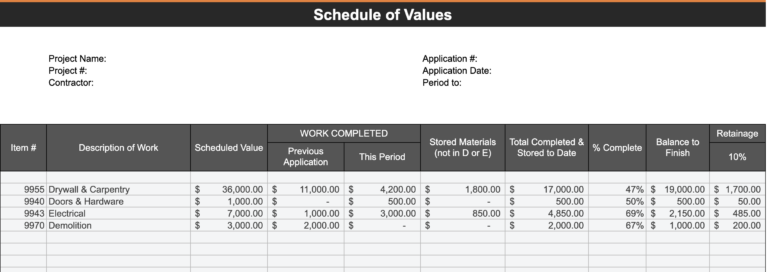— 16 min read
Schedule of Values in Construction Explained
Last Updated Dec 9, 2024
Last Updated Dec 9, 2024

A schedule of values (SOV) is an itemized list of each activity required to complete the scope of work on a construction project, along with the corresponding costs or values. The SOV serves as a complete representation of the project, detailing all the elements and activities from construction kickoff to closeout. The values in the SOV reflect the payment that the contractor is entitled to receive upon the completion of each work component, and when summed up, should match the total agreed-upon contract amount.
A schedule of values is a valuable management tool that aids in financial control, payment management, project monitoring and documentation. A well-crafted SOV promotes effective communication, transparency and informed decision-making between all project stakeholders. At its core, the SOV serves as a roadmap that guides the financial management and progress of the entire construction project.
In this article we break the schedule of values down, explaining how it is created, the different components, SOV templates and practical application for cost and progress management. Whether you’re an experienced project owner or general contractor or new to the industry, we’ll explore everything you need to know about the schedule of values and how to use it effectively for successful financial management and project delivery.
Table of contents
SOV Basics
The schedule of values (or SOV) offers a comprehensive breakdown of the various tasks or scopes associated with a construction project, along with their respective costs or values. When these individual amounts are summed up, they equate to the total contract value of the entire project. The SOV serves as a fundamental tool for progress billing and change orders and plays a crucial role in monitoring the progress of completed work in comparison to the planned work.
For project owners, the SOV provides transparency and accountability in regards to project costs and financials. It gives them insight into how the total contract amount is being allocated to different work items or scopes.
A well-defined SOV fosters transparent payment practices as it explicitly states the assigned value for each work item. This clarity empowers owners to make payments to contractors in accordance with the percentage of completed work, ensuring fairness in the payment process.
In addition, by referring to the SOV, owners can monitor the progress of work and compare it against the planned schedule. This allows them to identify potential delays or deviations and take proactive measures to mitigate risks and keep the project on track.
A well-crafted SOV also serves as a valuable tool for contractors to manage their projects efficiently and ensure financial stability. It is an overarching guide of the work to be completed and corresponding payment milestones. The SOV acts as the foundation for billing, outlining steady and consistent cash flow for the contractor throughout construction as the project progresses to subsequent stages. In addition, a well-organized SOV facilitates effective resource planning and allocation, promoting optimal utilization of labor, materials and equipment.
Broadly speaking, the schedule of values serves as the foundation for budgeting a project. However, in the day-to-day operations of delivering a construction project, it provides the fundamental framework for monitoring project progress and managing invoicing.
Stay updated on what’s happening in construction.
Subscribe to Blueprint, Procore’s free construction newsletter, to get content from industry experts delivered straight to your inbox.

How to Create a Schedule of Values
Prior to construction kickoff, the general contractor is typically responsible for creating the schedule of values. This process lays the foundation for the project’s execution. By outlining all the essential steps involved, the general contractor develops a roadmap to reference and navigate the construction stage effectively and efficiently.
The contractor develops the SOV based on the total contract sum and the scope of work specified in the contract. The entire scope is broken down into individual tasks or deliverables and then assigned a corresponding value (i.e. scheduled value). These values include both direct and indirect costs.
The contractor submits a “pencil draft”, or preliminary version of the SOV, to the project owner, and sometimes the architect and owner’s representative. The project owner reviews the SOV to ensure that there is a clear alignment between their understanding of the cost breakdown and timelines and that of the contractor.
The owner provides feedback, requests adjustments and asks for further clarification on the cost breakdown. Together the contractor and owner finalize the schedule of values, creating the foundation for pay applications, change orders and tracking project progress. This collaborative process fosters transparency and mutual understanding between the project owner and contractor, facilitating a clear comprehension of the project's financial aspects, schedule and milestones.
What to Include in a SOV
Here’s a breakdown of the components included in the schedule of values, typically seen as columns, from left to right.
| Component | Description |
|---|---|
| Project Information | This section, usually located in the header, provides high-level information about the project including the project name, project number, project address and the contractor firm name. |
| Item Number | Each line item is assigned an item number, which represents a specific work activity or task involved in the construction project. Line items are numbered sequentially and are assigned a corresponding description that clearly identifies the scope of work. The totality of these items represents the entire scope of work. |
| Description of the Work | A detailed description of the work to be performed. |
| Scheduled Value | The associated estimated cost of each work item or task. The total amount represents the payment amount due to the contractor upon completion. |
| Start and End Date | The scheduled start and end dates for each task. These values are used when establishing the project schedule and for tracking project progress. |
| Work Completed | The amount of work completed for each line item including:The total dollar amount of work that was listed as completed in previous pay applicationsThe dollar amount of work completed in the current period (essentially all completed work that was not captured in any previous pay applications) |
| Stored Materials | The cost of materials purchased but not yet used on the construction project. Serves as a mechanism for contractors to recover the costs of purchasing and storing materials. This number does not include the value of materials accounted for in the work completed. |
| Total Completed + Stored-to-Date | The total dollar amount of the work completed and materials stored for each work task. |
| Percent Complete | The percent of work complete for each line item or task. It represents the progress made on each individual work activity or component. |
| Balance to Finish | The value of work still remaining until the work task is complete. |
| Retainage | The portion of each progress payment that is withheld until the completion of the project to ensure the contractor fulfills all contractual obligations. The percentage typically ranges between 5-10%. This is applied to the scheduled value of each work task to calculate the corresponding retainage dollar amount. |
| Total Cost | The cumulative value of all individual tasks, which should precisely match the total project cost. This provides a comprehensive overview of the project's overall financials. |
Schedule of Values Template
Many contractors utilize templates to generate their schedule of values on construction projects. Two commonly used templates are the AIA G703 Continuation Sheet and ConsensusDocs 293: Schedule of Values.
On projects using AIA or ConsensusDocs contract documents, contractors should use the corresponding appropriate forms for the schedule of values.
However, for projects where a specific form is not required, this schedule of values template based on the AIA Continuation Sheet, is another option.
Free Download
Schedule of Values Template
Owners use a schedule of values to assist with payment management, project monitoring and financial documentation. Download and customize this free template to track projects costs and values throughout a project.
- Customizable to project needs
- Ready-to-use
- Made by and for construction professionals


How the Schedule of Values is Used
The schedule of values is a vital tool used on construction projects for a variety of reasons including the following:
Payment management
The SOV serves as the basis for contractors to request and receive payments for completed work, also known as progress billing or payment applications. It outlines the value assigned to each work item, enabling contractors to track their payment entitlements and ensure fair compensation for the work they have performed. This also enables owners to easily verify the accuracy of payment requests.
Project progress tracking
The SOV aids in monitoring the progress of work against the planned schedule. By comparing the actual completion of work to the scheduled values specified in the SOV, contractors can evaluate their productivity, detect any delays and implement corrective measures to keep the project on track. Simultaneously, the SOV empowers project owners to monitor project progress and assess contractor performance. It allows them to identify deficiencies, delays or potential issues and take prompt actions to address them effectively.
Financial planning and cash flow management
The SOV serves as a crucial tool for both project owners and contractors in terms of financial planning. For project owners, it provides valuable insights into the expected billing for each period, aiding in budgeting and management of high-level finances. For contractors, by referring to the SOV, they are able to effectively manage their cash flow as it enables them to anticipate and plan around the predetermined payment timelines.
Resource and manpower management
Similar to the SOV providing an understanding of the project’s progress, the SOV allows contractors to estimate the resource requirements for each work item or phase. By understanding the scope and complexity of the tasks outlined in the SOV, contractors are able to determine the appropriate level of resources needed, including the number of workers, specific skills required, equipment specifications and material quantities. The SOV also helps contractors create a detailed project schedule, which ensures that resources are allocated at the right time and in the correct sequence to meet project milestones and deadlines.
Conflict resolution and contractual compliance
Incorporated into the contract, the SOV provides a clear and transparent breakdown of the agreed-upon project scope and values, establishing an objective reference point for all project stakeholders. By referring to the SOV, all parties possess a shared understanding of the financial and other aspects of the project, which can help foster constructive dialogue and aid in finding mutually acceptable resolutions.
Change order management
The SOV establishes a structured framework for effectively evaluating and managing changes to the project scope. It serves as a comprehensive record of the project's original scope, enabling efficient tracking and communication of any modifications. This ensures that all involved parties possess a clear understanding of the adjustments made and the subsequent impact on costs, promoting transparency and effective change order management.
Cost control
The SOV assists in cost control as it provides a detailed breakdown of the project's cost structure, including the anticipated costs for each work item or phase. This allows contractors to monitor and manage their expenses effectively. By tracking the costs associated with each work item, contractors can identify potential budget overruns, make informed decisions and implement cost-saving measures as needed. This, in turn, also provides owners with a comprehensive overview of costs and allows them to monitor that the project stays within the defined budget.
Common Mistakes
When creating a schedule of values, several common mistakes often occur. Here are a few of them to watch out for, and the negative impacts that often result.
Frontloading
Contractors “front-load” the SOV so that a disproportionate amount of the contract value and associated payments are allocated to the early work of the project. This is achieved by artificially inflating the value of the work in the beginning stages of the project while reducing the value of tasks that occur later on.
While frontloading improves the contractor's cash flow, it may pose risks in the later stages of the project if the work is not delivered as expected.
Lack of specificity
The SOV should provide sufficient detail for each item to avoid any ambiguity. Vague or generalized descriptions can lead to misunderstandings, disputes and potential change orders during later project stages.
For example, simply labeling a task as “Electrical Work” does not specify what specific electrical tasks or components are included in that scope of work. By breaking down the category of "Electrical Work" into the specific requirements and deliverables, each component can be accurately measured and billed accordingly.
This detailed itemization allows for precise tracking of the work performed, ensuring transparency and facilitating accurate invoicing.
Inaccurate & inconsistent cost estimation
One of the primary purposes of the SOV is to assign prices or values to each item or task. Mistakes often occur when pricing items due to using outdated or incorrect rates, inconsistent pricing methods or failing to account for all the costs or work associated with an item. This can result in budget overruns or shortfalls.
Overlooking indirect costs
The SOV aims to encompass all costs related to a construction project, including both direct and indirect expenses. Failure to adequately consider or incorporate indirect costs in the SOV can result in an incomplete financial picture.
This can lead to inaccurate representation of the project's total costs, potentially resulting in inadequate budgeting or underestimation of overall expenses. Such oversights not only impact cash flow management and the availability of funds for essential project activities and expenses, but they can also have a significant effect on the project's profitability.
Not incorporating changes
Failing to update the schedule of values to include approved change orders can cause discrepancies in the payment schedule as well as misunderstandings regarding scope which can lead to disputes over additional costs and work.
Insufficient review and negotiation
Failure to conduct a comprehensive review and negotiation of the SOV can result in disputes later on. It is essential that both the project owner and the general contractor reach a mutual agreement on the contents of the SOV before kicking off construction.
Disregarding contractual requirements
Not aligning the schedule of values with the specific contractual requirements can also result in cost overruns, non-compliance and potential legal issues.
Schedule of Values Example
Let’s examine how a SOV works in the case of a hypothetical construction project.
Project Background
Greene Construction, a national commercial general contractor, was awarded a contract for the new Hilltop Airport, a $775 million new airport. The project is complex with multiple phases and different buildings and structures as well as the large number of speciality contractors needed to complete the work. As the client, the Port relies on Greene Construction’s depth of experience and construction expertise to create the schedule of values in order to track the project's billing and progress as well as effectively manage all financial aspects.
Creating the Schedule of Values
As Greene Construction is a larger general contractor, the creation of the schedule of values is a combined effort of the project manager and the estimating team. In practice, this collaboration is vital to the creation of a well-crafted SOV. The project manager provides the necessary project-specific information, oversees the SOV's development and ensures that it aligns with the overall project strategy and requirements. The estimating team provides the technical expertise in cost estimation and precise breakdown of the project's expenses.
Design and specification review
Greene’s team reviews the architectural drawings and project specifications, analyzing the scope of work involved in constructing the new airport. With a clear and detailed understanding of the project's scope, the team begins the process of itemizing the tasks into separate line items for the SOV. This breakdown aligns with CSI divisions.
Next, the team estimates the required quantities and costs for each line item based on their expertise and historical data from similar projects.The estimating team consults market rates, supplier and specialty contractor quotes and recent cost data to determine the unit prices for the materials and services involved. The unit prices are then multiplied by the estimated quantities to calculate the total value of each line item.
Confirm SOV accuracy
Once the team completes the breakdown and calculations, they review and verify the SOV's accuracy and completeness. They cross-check their estimates and scrutinize the descriptions of work to ensure clarity and consistency. The project manager consults with the superintendent to create start and end dates of each line item or task. The project manager also ensures that the SOV adheres to the project's contractual requirements and is aligned with the client's expectations.
Greene Construction, representing the initial or preliminary version before formal approval and finalization. The owner carefully examines each line item, seeks clarifications when items are unclear, and discusses any necessary revisions with the contractor. Together, they reach an agreement on the final SOV, including the breakdown of costs and quantities, making any adjustments or additions as needed.
Benefits Realized During the Project
Throughout construction, the SOV benefits Greene Construction and the project owner in several ways:
- Progress Billing: The SOV allows Greene Construction to easily bill for completed work items or tasks. This allows the general contractor to manage their cash flow, track pay applications and pay their subcontractors for the work they completed in a timely manner.
- Progress Tracking: The SOV plays a vital role in monitoring the project’s progress. When scopes of work are delayed or behind schedule, the SOV clearly highlights the disparity between the planned and actual completion of the work. With this clarity, Greene Construction is promptly able to take necessary measures to rectify the situation and bring the project back on schedule.
- Change Order Management: In the event that the project owner opts to add additional scope to the project, Greene Construction efficiently computes the additional costs, presents the change order to the owner and subsequently updates the SOV to accurately reflect the modifications made.
By leveraging the schedule of values throughout the project, Greene Construction successfully delivered this large-scale construction project. Hilltop Airport, the owner, valued the transparency and financial control enabled by the meticulously crafted and diligently maintained schedule of values, which further cultivated trust and respect between both parties.
Additionally, Green Construction effectively utilized the schedule of values to manage their cash flow, allocate resources efficiently and closely monitor project progress.
Stay updated on what’s happening in construction.
Subscribe to Blueprint, Procore’s free construction newsletter, to get content from industry experts delivered straight to your inbox.

Using Technology to Create and Manage an SOV
The integration of technology into construction processes continues to streamline tasks, improve accuracy and facilitate enhanced collaboration.
In regards to creating and managing the schedule of values, utilizing technology provides several advantages, including:
- Automation: Several project management and estimating software are able to automatically create an SOV based on the project’s budget. These preliminary SOV drafts can be reviewed and refined but overall reduce administrative burden and possibility of error.
- Real-time updates: Cloud-based systems allow project owners, general contractors and speciality contractors to all access the same document simultaneously, ensuring all parties are up-to-date on the most current version. This helps facilitate greater collaboration and community and increase operational efficiency.
- Progress tracking: With different project management software, it is easier to track the progress of each line item in the SOV, automatically updating completion percentages and facilitating accurate progress billings.
- Integration with billing software: Linking the SOV to billing and payment digital progress can help to streamline these processes. The integration streamlines the entire procedure, expediting payment release for completed work milestones. Additionally, it ensures adherence to the specific invoicing procedures required before authorizing payments.
Promotes communication and transparency: Creating a digital SOV enables all project stakeholders to easily access and exchange current information, fostering a shared understanding of the project's financial status and progress.
Was this article helpful?
Thank you for your submission.
93%
7%
You voted that this article was . Was this a mistake? If so, change your vote here.
Scroll less, learn more about construction.
Subscribe to The Blueprint, Procore’s construction newsletter, to get content from industry experts delivered straight to your inbox.
By clicking this button, you agree to our Privacy Notice and Terms of Service.
Categories:
Written by
Colton Stokwitz
Colton Stokwitz is a Program Manager at Shoreline CPM. Based in San Diego, Colton spent 11 years working as a project controls manager, lead interior superintendent and senior cost analyst at Turner Construction. He has a Bachelors of Science (BSc) in Construction Management from California Polytechnic State University-San Luis Obispo.
View profileTaylor Riso
73 articles
Taylor Riso is a marketing professional with more than 10 years of experience in the construction industry. Skilled in content development and marketing strategies, she leverages her diverse experience to help professionals in the built environment. She currently resides in Portland, Oregon.
View profileExplore more helpful resources

Construction Manager vs. Project Manager: Comparing Leadership Roles
Skillful oversight of construction projects allows companies to deliver to owners on time and within budget. Construction managers (CMs) and project managers (PMs) provide the necessary supervision to keep projects...

Mastering Construction Resource Management: Strategies for Success
Completing construction projects successfully requires the careful management of various resources: labor, materials, equipment, money, time and information. Since these resources are finite, allocating them wisely is crucial for minimizing...

Managing Construction Projects in Different States: A Contractor’s Guide to Working Across State Lines
For many general contractors, taking on work in a new state or region can offer transformative opportunities for building a thriving business and a respected reputation. But managing projects is...

Construction Teamwork: Build a Solid Foundation With the Right Team
Construction is an industry of collaboration — no one person completes any job on their own. It could easily be argued that the most important skill for anyone in this...